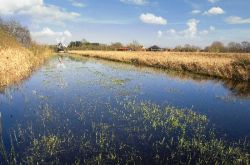The challenge
Wetlands have been threatened by losses for centuries, with drainage and conversion for intensive agriculture, peat harvesting and river channel modification significantly reducing the area of wetlands and their character.
Restoration of wetlands has multiple benefits including wildlife conservation, tourism and amenity, flood prevention – but when the land surrounding degraded wetlands has itself been modified, how can regulators or conservation groups know if wetland restoration will be effective and given likely climate change, whether it will actually be sustainable in the long term?
The solution
The restoration of wetlands needs to be viewed from a ‘catchment’ perspective, rather than in isolation, with close attention being paid to the quantity and quality of water flowing into the wetland area and drainage from the wetland. Not all of these processes take place on the surface, and an understanding of soils and groundwater flows is also highly important.

The Great Fen
Fundamental research into wetlands hydrology undertaken by CEH and BGS has provided a sound scientific basis for wetland conservation initiatives such as Wetland Vision, a collaborative initiative supported by the EA, English Heritage, Natural England, the RSPB and the Wildlife Trust. The research has also had many practical applications in ensuring the long-term sustainability of restored wetlands:
- CEH have carried out a 10-year programme of research into the feasibility of the Great Fen project, one of the most high-profile wetland restoration projects in the UK.
- CEH assessed the effectiveness of re-instating surface channels to achieve wetland restoration
- The flood reduction potential of wetlands has been assessed by CEH by computer modelling and extensive synthesis of scientific literature
- CEH have led the development of a web-based tool to help wetland managers model the impacts of climate change over the next 50 years.
Detailed studies have been carried out by CEH of a number of other wetland restoration projects, including Tadham Moor and Wicken Fen.
Resulting benefits
The high profile Great Fen Project aims to create a 3,700-hectare wetland providing conservation benefits for wildlife, and helping address the increased need for flood protection in the area for 70,000 ha of farmland, together with local homes and businesses.
As the Great Fen develops over time, opportunities for tourism will grow, both natural tourism (where visitors are attracted by landscape, habitats, and species) and outdoor leisure (where visitors come and enjoy recreation and sports pursuits, education, heritage and the arts).
Future directions
Current research at CEH is focusing on using our scientific knowledge to provide guidance on restoration and management of different wetland types ranging from dune slacks, through floodplains to fens, particularly quantifying the benefits to people.
None listed.
Acreman, M.C., Blake, J.R., Booker, D.J., Harding, R.J., Reynard, N., Mountford, J.O., Stratford, C.J. 2009 A simple framework for evaluating regional wetland ecohydrological response to climate change with case studies from Great Britain. Ecohydrology 2, 1-17.
Acreman, M.C., Harding, R.J., Lloyd, C., McNamara, N.P., Mountford, J.O., Mould, D.J., Purse, B.V., Heard, M.S., Stratford, C.J., Dury, S. 2011 Trade-off in ecosystem services of the Somerset Levels and Moors wetlands Hydrological Sciences Journal. 56, 8, 1543-1565
Acreman, M.C., Holden, J. (in press) Do wetlands reduce floods? Wetlands 33:773–786
Acreman, M.C., 2013 Supporting wetland managers to project the impacts of climate change on wetlands in England and Wales: a risk-based web tool. Norfolk & Suffolk Broads Conservation Group, Hydrology Seminar. Norwich, April 2013
Acreman, M.C., Blake, J. 2013 Projecting the impacts of climate change on wetlands in England and Wales using a risk-based web tool. Proceedings of the 4th International Conference on Hydrology and Ecology – Emerging patterns, breakthroughs and challenges, Rennes, France May 2013
Acreman, M.C., Blake, J. 2013 Predicting uncertain impacts of climate change on wetlands: a risk-based web tool for England and Wales. In: Borin, M., Malagoli, M., Salvato, M., Tanis, B. (eds) Wetland Systems: ecology, functioning and management. Proceedings of the International conference of the Society of Wetland Scientists. 71. Piante Acqua Natura, Padova, Italy.
Customer:



Sources of funding
Previous projects funded by NERC and EA.








 The Water Security Knowledge Exchange Portal supports the objectives of the
The Water Security Knowledge Exchange Portal supports the objectives of the 